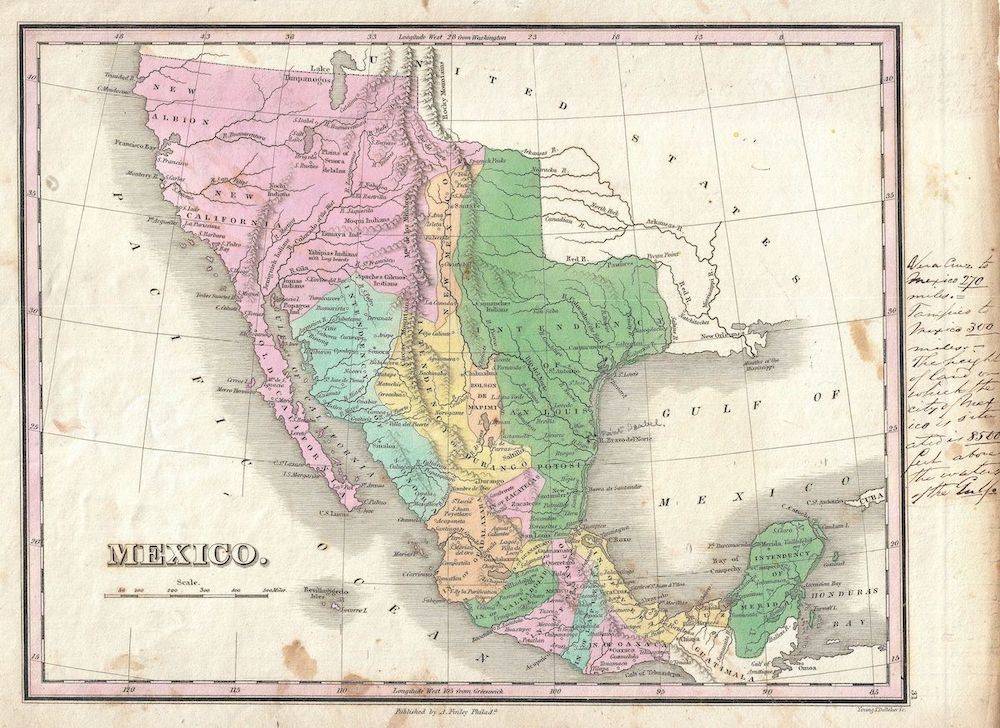By Bill Gallegos

(This article is based on my presentation given at a Solidarity with the People of México event on September 22nd in Los Ángeles. In several respects this presentation is a critique of the US left, including the socialist left, that has ignored the importance of the 1848 annexation of México’s northern territories. This failure to analyze the significance of annexation for US economic and political development, the under-development of México, and the evolution of an oppressed Chican@ Nation within US borders remains a strategic weakness of our movement. Most organizations in the US left, including communist and “new communist organizations” paid little or no theoretical attention to these matters, or – in the case of Chican@s and Mexican@s in the US – narrowed the question primarily to an immigrant rights issue, or an even more narrowly-defined labor issue. Current events in México and at the US border have forced the question onto the political landscape, and yet the left has been largely unable to offer leadership or a coherent response to both the Trump Administration’s ethnic cleansing campaign, or to the new progressive political developments in México with the election of Andrés Manuel López Obrador and the Morena Party.
This new piece from Liberation Road is our latest contribution to the US left and progressive movements in our organization’s efforts to define a strategy toward achieving socialism. It is connected to earlier contributions from our predecessor organizations: Fan the Flames, The Struggle for Chicano Liberation, and The Sunbelt Strategy and Chicano Liberation. It highlights the importance of our struggle to dismantle US imperialism and support the struggle of the nearly 40 million Chican@s in the US; to grasp the strategic importance of linking that struggle with left and progressive social movements in México; and to deepen our Sunbelt Strategy analysis of several years ago. This strategy is rooted among not only the Chican@-Mexican@ people in the Southwestern US, but with the more than 25 million African Americans in the US South. The Sunbelt is also home to the largest Indigenous populations within US borders, as well as the largest concentrations of Asian Pacific Islanders, and large concentrations of white workers.
Foundational to this history are the original peoples that populated the hemisphere thousands of years before 1492, before the origins of a Mexican state, before the US annexation of Northern México. Resisting the hundreds of years of extermination campaigns by Spain, by México, by the United States of America that decimated their populations, native peoples have always fought back. Their long memories and knowledge of their ancestors’ histories are the foundation of their tradition of resistance, and of their dignity.
Unless we understand and focus on the strategic significance of the interlocking histories and connections between the peoples in the geographic areas that were once Mexican and now are part of the US, we will not win.)
US Expropriation of Mexican land, 1845 -1848
There is an important series of events in U.S. history that receives very little attention as to its tremendous historical and contemporary significance: the annexation of México’s northern territories by the United States, beginning with the Mexican state of Texas in 1845, and virtually half of México after a short, unjust and inglorious war, ratified in the 1848 Treaty of Guadalupe Hidalgo. These territories include the states of Nuevo México, Nevada, Arizona, California, Texas, Utah, and western Colorado.
These historical events represent the third foundational phase in the construction of a white supremacist imperialist superpower, which would, within a century after annexation, dominate the world. The first phase was the genocide of Native peoples and the seizure of their lands and resources, clearing the way for European settlement. The second was the importation and exploitation of Africans as slave labor to kick-start the US capitalist economy. And the third phase that laid the basis for eventual US global hegemony was the defeat of México in the Mexican-American War of 1846 – 1848 and the subjugation of Mexicans in the Southwestern United States.
The annexation of México’s northern lands, largely through military aggression (labeled by Ulysses S. Grant as “imperialist” and opposed by then Congressman Abraham Lincoln) had three major outcomes:
It enabled the United States of America to become the dominant capitalist superpower in the world.
The United States spread its reach from the Atlantic coast to the Pacific coast, as it proclaimed was its God-given right (Manifest Destiny), thereby allowing for a vast expansion of the Anglo population as primarily settler colonists of the newly-acquired territories. The US war against México was motivated primarily by the Southern US slaveocracy, which hungrily sought new territories for its plantation economy and the lucrative slave trade.
If México’s northern territories not been seized, the United States might well have become a second or third-rate power like Spain or France, but hardly the super-power of today. Through this annexation, the United States acquired some of the most fertile agricultural lands in the world, lands also rich in oil, coal, uranium, gold, silver, copper and other mineral deposits.
Profoundly important for its ascension to a global powerhouse, the USA acquired maritime access to trade and resource extraction along the entire Pacific Rim. Otherwise, it would not have controlled ports on the Pacific.
2. It subordinated México to US interests
Before the US war of aggression against México, the two nations were roughly co-equal in size. México owned the gateways to the Pacific, and the rich natural resources necessary for capitalist development.
Due largely to the loss of its northern territories, México effectively became a neo-colony of the US, a dependent nation of the Global South. The signing of the Treaty of Guadalupe Hidalgo in 1848 ratified this historic theft. México now was confronted with a nearly 2000-mile imposed border with a militarily superior power. The movement of people from one side to the other became restricted.
Before the war with the US, México had won its independence from Spain only 25 years prior, in 1821. Its first black president (ours not until 2008!) Vicente Guerrero abolished slavery in 1829. While México has had its own internal struggles and may have had conservative politics dominate even without US interference, it certainly would have been a more sovereign nation less prone to US meddling.
3. The Annexation of México’s northern territories led to the evolution of a new oppressed nationality: the Chican@/Mexican@ people.
The Chican@/Mexican@ people have evolved as a distinct and oppressed nationality, separated for generations from their homeland (although family ties have always been maintained). The white-supremacist capitalist class prevented them from assimilating as equals with the dominant European majority and thereby from enjoying the rights and freedoms accorded to whites.
Following annexation, the United States consolidated its conquest through a policy of terrorism, bribery, and trickery. While the Treaty of Guadalupe Hidalgo promised that existing landowners in what became US territories would not lose ownership of their land, those promises were not kept. Mexicans were stripped of their assets: 525,000 square miles (1,359,744 square kilometers) of land were taken through force, murder, trickery. The lack of assets and basic rights created a subordinate racialized group whose main option was to become a cheap labor force for the new white-owned agricultural enterprises.
Ensuing laws and practices institutionalized inequalities for the Chican@ people. These included the denial of their language and culture, residential segregation, inferior public education (like African Americans, they also had to sue to gain admission to white-only schools), racist credit and banking systems, police and state repression, denial of voting rights, job discrimination, and so on. Today, these basic structures remain in place and maintain inequality for Chican@s in all realms of US economic, political, cultural, and social life.
Because of the early abolition of slavery in México and the right of Mexican women to own land, something not allowed in the US at that time, blacks and women also lost rights due to annexation and suffered greater oppression than they would have in México.
Mexican@/Chican@ Resistance Across Borders
90% of the 37 million Chican@ population in the US reside in the historic pre-annexation areas: Texas, California, Arizona, Nuevo México, and Colorado. Over the last several decades they have been joined by significant numbers of immigrants and refugees from Central America, who often live in the same neighborhoods, send their children to the same public schools, work in many of the same low-wage jobs, and suffer from the same structures of oppression as their Chican@ sisters and brothers. These geographic areas of historic Chican@ concentration are the Chican@ homeland, la patria, la nación. With our blood, sweat, and tears, Chican@ labor has built much of this area’s economy, its agricultural system, its transportation, energy, and manufacturing infrastructures.
But oppression breeds resistance! Chican@ resistance is comprehensive and ubiquitous: union organizing and strikes, armed struggle, broad and diverse cultural forms (Spanish language press, media, art, music, teatro, etc.), legal challenges, grassroots fights for economic and educational inclusion, for immigrant rights, and for environmental and gender justice. Today, resistance has also taken the form of electoral organizing.
As a result, Chican@s have become a major force in the electoral arena. On the one hand they are wooed by politicians. But on the other, the ruling class has stepped up efforts to restrict our vote through gerrymandering and voter suppression laws, especially in states like Texas and Arizona where we are fast becoming a majority. The backlash is worse than that: the racist right-wing, sometimes referred to as the New Confederacy, has, under Donald Trump, unleashed an ethnic cleansing campaign against our people, a campaign that has incarcerated hundreds of thousands, includes the imprisonment and death of children, massive family separation, growing rates of deportation. These measures have fomented a pervasive atmosphere of fear in Chican@ barrios – and have sparked organizing efforts in defense of our brothers and sisters.
The ferocity of the attacks serves to prove that Chican@s pose an existential threat to the US empire. We are not only a young, growing and dynamic population, but are connected by a thousand ties – historical, familial, cultural, economic, ideological – to the dynamic and growing social movements in México. All this makes more clearly evident the necessity to unify the Chican@ movement and to raise once again our program for national rights to land, self-government, and control of our economy. The long history of US interference in México and its oppression of Mexican@s/Chican@s in the US makes clear the strategic importance of building solidarity with the people of México whose fates have been connected to those on the Northern side of the border. Together, we can be a mighty force.
Solidarity with the people of México is a central element of our internationalist strategy to build unity among all oppressed and working peoples of the US and beyond. Imposed borders, artificial lines in the sand, cannot stop us. We can build opposition to US interference in México, open space for México to exercise its sovereignty, and remove barriers between peoples with the same historical roots. In our striving to end imperialism, working people can construct societies that are just, egalitarian, peaceful, and genuinely democratic, in which no nationality or gender is privileged, that live in close connection and harmony with Mother Earth, and most especially that are Sin Fronteras.
¡Si Se Puede!
(Liberation Road, September 22, 2019













